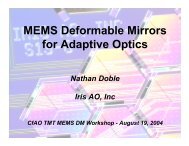5 FOURIER DOMAIN PSD MODELING 37wherewedefined=∑N l N l∑l=1 k=1〈〉˜ϕ † l (f,t) ˜ϕ k(f,t) Γ † l (f)Γ k(f), (178)∞∑Γ l (f) =1− sinc(f · v l t i )exp(2πif · v l t d ) g (ξ − g) n−1 exp(2πif · v l nt i ). (179)Separate turbulence layers are assumed to be uncorrelated, i.e. 〈ϕ l ϕ k 〉 = 〈|ϕ l | 2 〉δ kl , so this simplifies to the tubulencePSD (155) and removes one summation. Defining a = ξ − g and b l =2πf · v l t i , the summation over n in expression(179) can be written∑ ∞S l = a −1 a n e inb l(180)n=1n=1∑∞= a −1 a n (cos nb l + i sin nb l ), (181)n=1This can be evaluated as two Fourier series that have closed analytical <strong>for</strong>ms:n∑r k cos kx = (1 − r cos x)(1 − rn cos nx)+r n+1 sin x sin nx1 − 2r cos x + r 2 , (182)k=0n∑k=1r k sin kx = r sin x(1 − rn cos nx) − (1 − r cos x)r n sin nx1 − 2r cos x + r 2 (183)These sums will convege as n →∞<strong>for</strong> any |r| < 1. Evaluating the asymptotic <strong>for</strong>ms, substituting back into (181)and combining terms gives eventuallye ib l− aS l =1 − 2a cos b l + a 2 . (184)We can now jump to the final <strong>for</strong>m of the PSD directly:wherewith a and b l defined as above.5.3.2 NoiseΦ sl (f) = 0.023N l(f 2 + f0 2) × ∑r −5/30l|Γ l (f)| 2 , (185)l=1Γ l (f) =1− sinc(f · v l t i )exp(2πif · v l t d ) ×g(e ib l− a)1 − 2a cos b l + a 2 (186)For WFS noise the function G n = R(ν n ), and the closed-loop PSD is given by〈Φ noise (f) = |F {s 0 (x,t)}| 2〉 (187)〈∣ {}∣ ∣∣∣∣ ∞∑∣∣∣∣ 2〉= F g (1 − g) n−1 R[ν n (x,t)](188)= g 2 ˜R† ˜Rn=1∞∑m=1 n=1∞∑(1 − g) m+n−2 〈˜ν m † (f,t) ˜ν n(f,t) 〉 . (189)Assuming spatially and temporally uncorrelated noise we have that 〈˜ν † m˜ν n〉= δmn Φ ν , the power spectrum of theinput noise ν. Defining a =(1− g) 2 we have thatΦ noise (f) =g 2 ˜R† ˜R Φν (f)∞∑a (n−1) . (190)n=1
5 FOURIER DOMAIN PSD MODELING 38The sum is a geometric series with the closed <strong>for</strong>m 1/(1 − a), and substituting the <strong>for</strong>m <strong>for</strong> the reconstructor from(164) gives the final expressionΦ noise (f) =g2 − g × Φ (ν(f) 1sinc 2 (fd) fx2 + 1 )fy2 . (191)5.3.3 Aliasing (open loop)In this section ϕ = ϕ ⊥ (and we drop the subscript ⊥ ), and G n = R[M(I n )], because perfect <strong>reconstruction</strong> can nolonger be invoked. This, generally speaking, leads to a mess. Doing the calculation first <strong>for</strong> the open-loop case (theclosed loop adjustment will be easier to implement afterward this way), the <strong>for</strong>m of the PSD isΦ alias (f) =〈|F {s 0 (x,t)}| 2〉 =〈 ∣∣∣˜R ˜M[In ( ˜ϕ)]∣∣ 2〉 . (192)Taking this one step at a time, we have that˜M[I 0 ( ˜ϕ)] = comb(fd) ∗ [sinc(fd) × 2πifI 0 ( ˜ϕ)] . (193)Introducing the shorthand notation f m = f − md −1 , we can evaluate this as˜M[I 0 ( ˜ϕ)] = 2πi ∑ ∑N lf m sinc(df m ) ˜ϕ l (f m ,t)sinc(f m · v l t i )exp(2πif m · v l t d ). (194)ml=1Including the reconstructor we can write˜R ˜M[I 10 ( ˜ϕ)] =2sinc(fd) × ∑ ∑N lA(f m ,t) ˜ϕ l (f m ,t)E l (f m ,t), (195)ml=1where we defined the two quantitiesA(f m ,t) = (f −1 · f m )sinc(df m ), (196)E l (f m ,t) = exp(2πif m · v l t d )sinc(f m · v l t i ). (197)Evaluating the modulus squared and applying ensemble averaging gives1Φ alias (f) =4sinc 2 (fd) × ∑ ∑ ∑ ∑〈〉A † (f m ,t)A(f m ′,t)E † l (f m,t)E l ′(f m ′,t) ˜ϕ † l (f m,t) ˜ϕ l ′(f m ′,t) . (198)m m ′ l l ′We are saved from total catastrophe by assuming that separate turbulence layers are uncorrelated, and that turbulenceat different spatial frequencies are uncorrelated also. The last term then becomes 〈 ˜ϕ † lm ˜ϕ l ′ m ′〉 = δ ll ′δ mm ′〈| ˜ϕ lm| 2 〉,andthe E l term loses its complex exponential to the modulus, which leaves the almost manageable final expression:Φ alias (f) = 0.00575sinc 2 (fd) ×∑m≠(0,0)∑N l(|f m | 2 + f0 2 )−11/6 (f −1 · f m ) 2 sinc 2 (df m ) r −5/30lsinc 2 (f m · v l t i ). (199)Note that the origin {m =0,n=0} is exluded from the double sum, but otherwise it runs over infinity. The termsof the sum quickly tend toward zero thanks to the steep power law of Kolmogorov turbulence, so in practise no morethan a handful of terms need to be summed in each direction; this makes the expression possible to compute.5.3.4 Aliasing (closed loop)Looking to the closed loop modifications, we are now rewarded <strong>for</strong> having done most of the cumbersome calculationsalready. The adjustment is simplest to account <strong>for</strong> by entering it into equation (197) of the E l term by simplysubstituting∞∑exp(2πif m · v l t d ) → g (ξ − g) n−1 exp[2πif m · v l (t d + nt i )] (200)n=1= g exp(2πif m · v l t d ) ×l=1e ib l− a1 − 2a cos b l + a 2 . (201)



